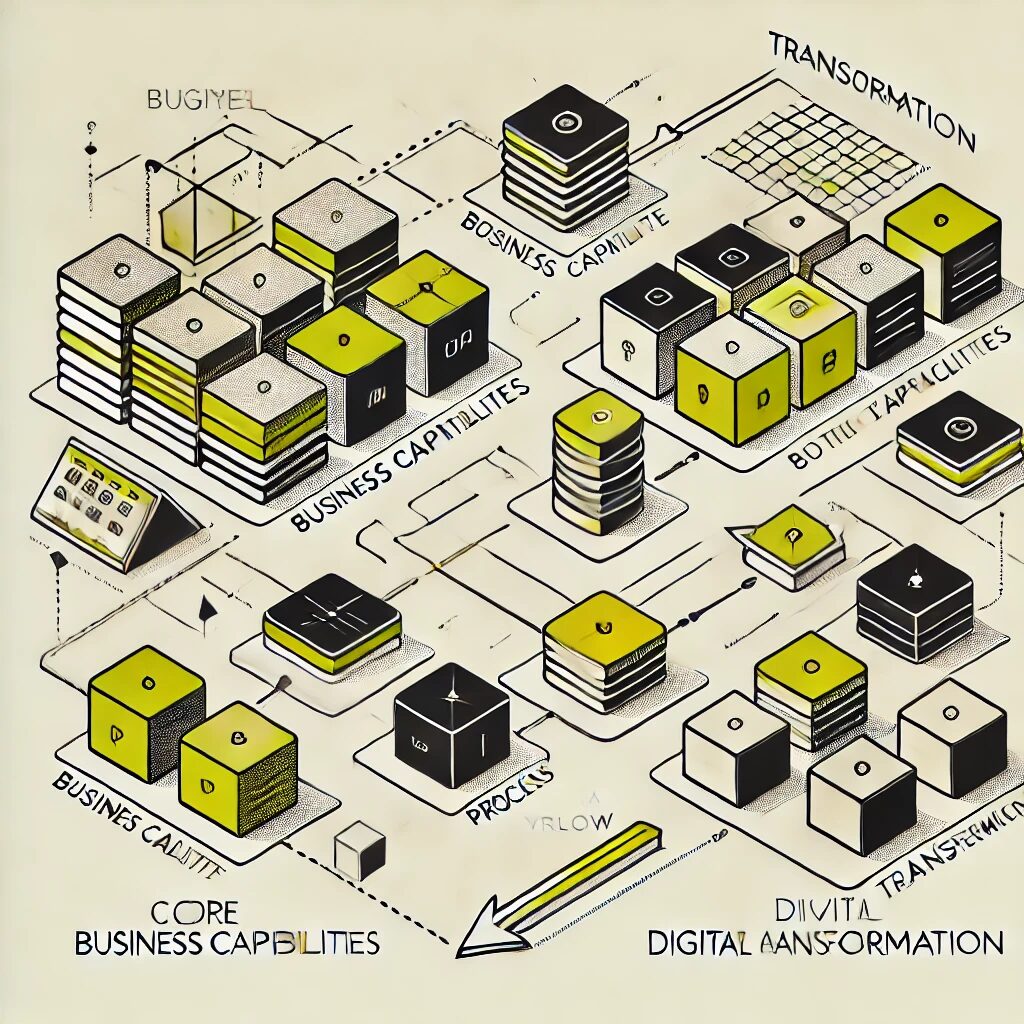
Enterprise Architecting Energy Leaders. Structure Before Strategy, Architecture Before Action
In the race to digital transformation, energy producers that succeed build on the solid foundation of enterprise architecture—while those that falter attempt to transform without architectural clarity.
The energy sector stands at a pivotal crossroads. While digital technologies promise unprecedented efficiency, resilience, and sustainability, the complex operating environment of energy producers creates unique transformation challenges. Enterprise architecture provides the essential structural foundation that bridges the gap between digital ambition and operational reality, ensuring that transformation initiatives deliver sustainable value rather than technological debt. For energy producers navigating this complex journey, architecture isn’t just enablement—it’s the difference between transformation success and costly failure.
1: The Energy Sector’s Digital Transformation Imperative
Energy producers face an unprecedented convergence of market forces and technological opportunities that make digital transformation both essential and challenging.
- Operational Efficiency Pressure: Intensifying competition from renewable energy sources and volatile commodity markets demand step-change improvements in operational efficiency that only digital capabilities can deliver.
- Grid Modernization Complexity: The evolution from centralized to distributed energy systems requires sophisticated digital orchestration across increasingly complex networks of assets and participants.
- Sustainability Imperatives: Decarbonization targets and environmental regulations create new operational requirements that demand digital monitoring, optimization, and reporting capabilities.
- Customer Experience Expectations: Rising consumer expectations for personalization, transparency, and control drive demand for digital engagement platforms that transform traditional utility relationships.
- Workforce Transformation: Demographic shifts and changing skill requirements necessitate digital tools that capture institutional knowledge, enhance productivity, and attract digital-native talent.
2: Why Digital Initiatives Fail Without Architectural Foundation
The energy sector’s transformation landscape is littered with digital initiatives that failed to deliver promised value, often due to fundamental architectural gaps.
- Siloed Implementation: Digital investments made without architectural guidance create disconnected point solutions that fail to address cross-functional challenges or deliver enterprise-wide impact.
- Technology-First Thinking: Transformation approaches that start with technology rather than business architecture lead to solutions in search of problems rather than strategic capability enhancement.
- Legacy Constraints: The energy sector’s extensive legacy technology landscape creates integration challenges and technical debt that derail transformation without architectural remediation.
- Scale Limitations: Pilot initiatives frequently fail to scale because they lack the architectural foundations for enterprise deployment, data integration, and operational support.
- Misaligned Governance: Transformation initiatives without architectural governance often conflict with existing systems, processes, and policies, creating organizational friction and adoption barriers.
3: Enterprise Architecture: The Digital Transformation Foundation
Enterprise architecture provides the structural framework that energy producers need to navigate complex transformation journeys successfully.
- Strategic Alignment: Architecture creates explicit connections between business strategy, operational requirements, and technology investments, ensuring digital initiatives advance strategic objectives.
- Transformation Roadmapping: Architectural analysis reveals the interdependencies and sequencing requirements that shape realistic, achievable transformation journeys across business and technology domains.
- Integration Framework: A well-defined architectural approach establishes standards, patterns, and interfaces that enable seamless information flow across organizational and system boundaries.
- Risk Mitigation: Architectural governance identifies and addresses compliance, security, and operational risks early in transformation initiatives, preventing costly remediation and rework.
- Resource Optimization: Enterprise architecture guides the rationalization of applications, infrastructure, and data resources, redirecting investment from maintenance to innovation.
Did You Know?
- Digital ROI Gap: While energy companies invested over $300 billion in digital transformation initiatives over the past five years, a 2024 industry study found that organizations with mature enterprise architecture practices achieved 3.4 times higher return on these investments compared to those lacking architectural governance.
4: The Energy Architecture Model: Key Domains
Energy producers require specialized architectural models that address the unique characteristics of their operational environment and value chains.
- Operational Technology Architecture: This domain addresses the specialized systems that monitor and control physical assets, including SCADA systems, distributed control systems, and smart grid technologies.
- Asset Information Architecture: Energy producers require specialized models for how asset information flows between engineering, operations, maintenance, and financial systems across the asset lifecycle.
- Trading and Market Architecture: This domain encompasses the systems, data, and interfaces that enable participation in energy markets, risk management, and financial settlement.
- Energy Delivery Architecture: Models in this domain address the end-to-end flow from generation through transmission and distribution to customer delivery, including grid management systems.
- Energy Transition Architecture: Modern energy producers need architectural models that support the evolution from traditional to renewable generation, carbon management, and prosumer engagement.
5: Building the Architectural Foundation: Business Architecture
Business architecture provides the essential starting point for energy transformation, connecting strategic intent to operational requirements before technology choices are made.
- Capability Mapping: Comprehensive inventory and assessment of what the organization does—from trading to generation to customer engagement—creates the foundation for targeted capability enhancement.
- Value Stream Definition: Mapping the end-to-end flow of activities that create stakeholder value reveals cross-functional inefficiencies and transformation opportunities hidden within organizational silos.
- Operating Model Design: Architectural models of how capabilities, processes, governance, and organizational structures interact guide holistic transformation rather than piecemeal improvement.
- Information Requirements: Business architecture identifies the critical information needed to support key decisions and processes, driving data governance and analytics priorities.
- Strategic Alignment: Mapping strategic objectives to business capabilities ensures transformation initiatives target the functions with greatest impact on competitive position and market performance.
6: Data Architecture: The Energy Transformation Enabler
Effective data architecture transforms information from a byproduct of operations to a strategic asset that drives digital transformation outcomes.
- Master Data Strategy: Energy producers require specialized master data models for assets, locations, customers, and products that create a consistent foundation for operational and analytical systems.
- Data Integration Framework: Architectural standards for how information flows between operational technology, IT systems, and external partners enable end-to-end digital processes.
- Analytical Foundations: Data architecture establishes the structures, tools, and governance that transform raw operational data into actionable insight for performance optimization.
- IoT Data Management: Specialized architectural patterns address the volume, velocity, and variety of sensor data that characterizes modern energy operations and asset monitoring.
- Data Governance Model: Architectural frameworks that establish data ownership, quality standards, and stewardship responsibilities ensure information assets maintain their value and trustworthiness.
7: Application Architecture for Energy Transformation
Application architecture guides the evolution from legacy systems to a modular, flexible application portfolio that enables digital business models.
- Core System Modernization: Architectural approaches for incrementally modernizing mission-critical systems like ERP, asset management, and trading platforms minimize disruption while enabling innovation.
- Integration Architecture: Standards, patterns, and platforms for connecting applications through APIs, events, and orchestration enable flexible, reconfigurable process flows across the enterprise.
- Digital Experience Layer: Architectural separation of user experiences from underlying systems enables consistent, personalized engagement for customers, employees, and partners.
- SaaS Integration Framework: As energy producers adopt more cloud services, architectural governance ensures these solutions integrate effectively with existing systems and data sources.
- Legacy Rationalization: Application portfolio analysis identifies opportunities to retire, replace, or consolidate systems that consume resources without delivering proportional business value.
8: Technology Architecture for Energy Operations
The unique requirements of energy operations demand specialized technology architecture that balances innovation with reliability and security.
- OT/IT Convergence: Architectural models that span traditional boundaries between operational technology and information systems guide integration strategies for digital operations.
- Edge Computing Framework: Technology architecture for distributing intelligence throughout the operational environment balances local responsiveness with centralized coordination.
- Cloud Adoption Strategy: Architectural guidance for what workloads belong in public cloud, private cloud, or on-premises environments ensures appropriate placement based on requirements.
- Security Architecture: Energy producers require specialized security models that address critical infrastructure protection, threat monitoring, and response capabilities across IT and OT.
- Resilience Engineering: Technology architecture that incorporates redundancy, failover, and recovery capabilities ensures operational continuity in an increasingly volatile operating environment.
9: Architecture for the Renewable Energy Transition
As energy portfolios evolve from traditional to renewable generation, architectural guidance ensures operational integration and performance optimization.
- Renewable Asset Integration: Architectural models for incorporating intermittent resources into generation portfolios address forecasting, dispatch, and grid integration challenges.
- Virtual Power Plant Architecture: Framework for aggregating distributed energy resources into dispatchable virtual assets requires integrated data, control, and market participation capabilities.
- Carbon Management Platform: Modern energy producers need architectural blueprints for carbon accounting, analytics, and reporting that span generation, operations, and value chains.
- Prosumer Engagement Architecture: As customers become active market participants, architectural models must support bidirectional energy flows, market participation, and settlement processes.
- Microgrid Orchestration: Specialized architectural patterns enable monitoring, control, and optimization of self-contained energy ecosystems operating connected or islanded from the main grid.
10: Architectural Approach to Energy Customer Experience
Digital customer experience represents a major transformation area for energy producers that requires cross-cutting architectural support.
- Customer Data Platform: Architectural foundation for integrating customer information across touchpoints creates a unified view that enables personalization and analytics-driven engagement.
- Omnichannel Architecture: Framework for consistent experience delivery across mobile, web, call center, and field interactions ensures seamless engagement regardless of channel.
- Self-Service Enablement: Architectural approach for exposing appropriate data and transactions to customers balances experience quality with security and operational considerations.
- Energy Insight Delivery: Models for collecting, analyzing, and presenting consumption data to customers create value-added services beyond commodity energy supply.
- Digital Solution Architecture: As energy companies expand into broader service offerings like home energy management, architectural patterns ensure these solutions integrate with core operations.
11: Architectural Governance for Energy Transformation
Without effective governance, even well-designed architecture fails to guide transformation initiatives effectively over time.
- Executive Sponsorship: Successful architecture programs establish clear leadership accountability for architectural integrity across business and technology domains.
- Compliance Framework: Energy-specific governance models address the unique regulatory requirements, industry standards, and operational constraints that shape transformation boundaries.
- Investment Alignment: Architectural review processes ensure capital and operational investments advance strategic capabilities rather than creating isolated technical assets.
- Standards Management: Governance mechanisms establish and maintain the technical standards, patterns, and guidelines that enable consistency without stifling innovation.
- Architecture Review Process: Structured evaluation of initiatives against architectural principles and standards identifies misalignment early when correction costs are minimal.
Did You Know?
- Implementation Success Rates: Energy producers with established enterprise architecture functions successfully scale 72% of their digital pilots to enterprise deployment, while companies without architectural guidance achieve only 24% scaling success, according to recent benchmarking research.
12: Building the Architecture Team for Energy Transformation
Effective enterprise architecture requires specialized skills and organizational positioning to influence complex transformation initiatives.
- Hybrid Expertise: Energy architecture teams need professionals who combine industry domain knowledge with architectural expertise to bridge business and technical perspectives.
- Operating Model: Successful architecture functions balance centralized governance with distributed implementation through hub-and-spoke models that maintain standards while enabling business agility.
- Business Engagement: Architectural value emerges from active participation in strategic planning and transformation initiatives rather than documentation created in isolation from business priorities.
- Capability Development: Progressive development of architectural skills across the organization creates architectural thinking beyond the core team, embedding governance in daily decision-making.
- Partnership Approach: Architecture effectiveness depends on collaborative relationships with project teams, viewing governance as enablement rather than enforcement to maintain relevance.
13: Architecture Roadmapping for Energy Transformation
Effective transformation requires architectural sequencing that balances quick wins with foundational capabilities for long-term success.
- Current State Assessment: Objective evaluation of architectural maturity across business, data, application, and technology domains establishes the baseline for transformation planning.
- Target State Visualization: Architectural models of the desired future state create a shared vision that guides investment decisions and initiative prioritization across the enterprise.
- Gap Analysis: Systematic comparison of current and target states across architectural domains identifies capability deficits that require attention in the transformation roadmap.
- Sequencing Logic: Architectural dependencies between capabilities, data, systems, and technologies determine the necessary order of implementation to avoid building on unstable foundations.
- Transition Architecture: For complex transformations, intermediate architectural states provide stable plateaus between major changes, enabling business continuity throughout the journey.
14: Measuring Architectural Impact on Energy Transformation
Demonstrating architecture’s contribution to transformation outcomes requires strategic metrics that connect structural improvements to business results.
- Strategic Alignment: Measurement of how effectively transformation initiatives advance priority capabilities and strategic objectives demonstrates architecture’s role in maintaining focus.
- Time-to-Market: Metrics comparing implementation time for similar initiatives with and without architectural guidance quantify the function’s impact on delivery efficiency.
- Integration Effectiveness: Evaluation of how seamlessly new digital capabilities connect with existing systems highlights architecture’s contribution to enterprise cohesion.
- Technical Debt Reduction: Tracking the elimination of architectural liabilities through transformation initiatives demonstrates long-term value beyond immediate functional benefits.
- Cost Avoidance: Quantifying duplicate investments prevented and rework eliminated through architectural governance establishes the function’s return on investment.
15: Future-Proofing Energy Architecture
Enterprise architecture helps energy producers anticipate and prepare for emerging industry shifts that will reshape operational requirements.
- Digital Twin Evolution: Architectural foundations for creating comprehensive virtual representations of physical assets and systems enable simulation, optimization, and predictive operations.
- AI Governance Framework: As algorithmic decision-making expands across energy operations, architectural models must address explainability, bias detection, and human oversight requirements.
- Quantum-Ready Architecture: Forward-looking energy producers are establishing architectural principles for quantum-compatible algorithms that will revolutionize optimization, forecasting, and security.
- Zero Trust Security: Evolving from perimeter-based to identity-based security models requires architectural transformation that spans technology, process, and organizational domains.
- Ecosystem Architecture: As energy value chains become more interconnected, architectural models must extend beyond enterprise boundaries to include partners, suppliers, and market platforms.
Did You Know?
- Technical Debt Impact: Energy sector CIOs report that lacking architectural guidance in early digital initiatives created technical debt requiring remediation equivalent to 38% of their current IT budgets, diverting resources from new capabilities to infrastructure maintenance.
Takeaway
Enterprise architecture provides the essential structural foundation that enables successful digital transformation for energy producers. By creating clear connections between strategic objectives, business capabilities, information requirements, applications, and technology, architecture transforms complexity from a barrier to an enabler of change. In an industry where operational reliability cannot be compromised during transformation, architectural guidance ensures that digital initiatives deliver sustainable value rather than creating isolated solutions or technical debt. For energy leaders navigating unprecedented disruption, enterprise architecture isn’t just a technical discipline—it’s the bridge between transformation aspiration and operational reality.
Next Steps
- Assess Your Architectural Maturity: Evaluate your organization’s current enterprise architecture practices against industry benchmarks to identify critical development opportunities across business, data, application, and technology domains.
- Connect Architecture to Strategy: Establish explicit linkages between your strategic objectives and the architectural capabilities required to achieve them, creating a foundation for prioritized transformation planning.
- Develop Cross-Domain Architectural Governance: Implement governance mechanisms that span business, data, application, and technology domains to ensure holistic oversight of transformation initiatives.
- Create Your Transformation Roadmap: Develop a sequenced plan for capability development that balances quick wins with foundational investments based on architectural dependencies and strategic priorities.
- Build Architectural Thinking: Expand architectural capability beyond a central team by embedding architectural principles and review processes into your organization’s standard operating procedures and decision frameworks.


